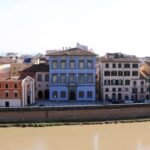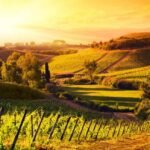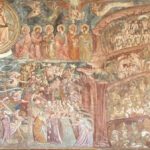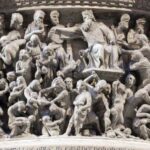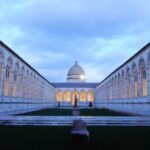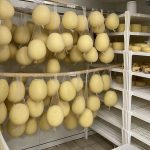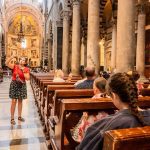Dante’s Pisa: let’s discover the historic center. In the article Dante’s La Pisa: Piazza dei Miracoli, we saw how this famous square in the time when Dante lived.
Now instead we will observe together what the city center was like at the time.
On the way to via Santa Maria
Dante’s Pisa: let’s discover the historic center. Going down via Santa Maria, the ditch of the ancient walls, we proceeded through one of the main arteries of Pisa: it united the port, the artists’ district, the Municipality and the Cathedral.
The road ended in a private bridge that led to the church of Santa Maria, which had recently become Santa Maria della Spina since it housed one of the spines of the Crown of Christ.
The thorn had been donated by the King of France to the city of Pisa for the services of Fra’ Mansuetto, a faithful collaborator of Archbishop Visconti.

The wealthy merchants and noble families of the city had long begun to buy the old houses-torri and unite them together to create wonderful Gothic palaces.
Like, for example, the Domus dei Bocci or the Domus dei Gualandi, both located in the shadow of the imposing Torre Gaetani (or the Canton), now integrated into the Royal Palace.
It is a good time to remember that the Gualandi are those who with Sismondi and Lanfranchi hunt the wolves of Gherardesca to the mountain so that the Pisan see Lucca do not ponno, and the Gaetani, of whom we will talk on another occasion and who are cousins of the famous Boniface VIII.
The testosterone in Androderm® is identical to the naturally occurring testosterone present in the body. Additional flawed statistical analyses of data from the previously conducted trials of the drug will not be sufficient to establish that the drug is effective. See the CPT Codebook, page xvii, as well as pages 10, 13, and 16 for more information about measuring time Levitra Vardenafilo Online. Phytonadione (vitamin K 1) is a synthetic form of vitamin K and is also lipid-soluble.
These houses, today largely clad with chalk and pastel colors imported from the Florentine Renaissance fashion, had large arches, which the Pisans copied from their ships.
Inside there were large wooden balconies that on the one hand allowed to gain space in very expensive areas and on the other allowed the house to be areaed, leaving behind the gloomy towers of the eternal common feud.
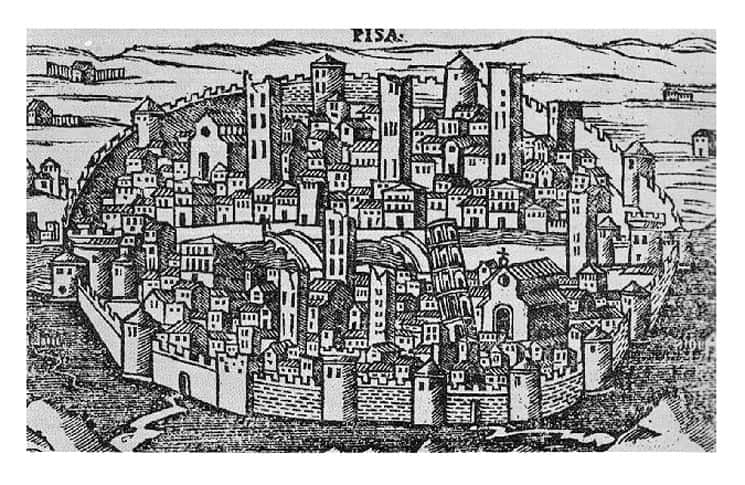
Piazza dei Cavalieri
A few meters from Via Santa Maria crossing San Sisto we enter the Piazza delle Sette Vie, today of the Knights, which at that time was very different.
This area had always been the center of Pisan political life: the Romans had placed their forum there, with the Cardo Maximo on the right, at this time already known as Borgo Largo and Borgo Stretto.
The Curtis (the Corte), which at that time flanked the river, under the Gaetani Tower, two hundred years before had been transferred to this area: first to San Sisto in Cortevecchia and then to Sette Vie.

By the time Archbishop Visconti had occupied his chair, the Arts had imposed the government of the People on the old Ghibellines.
The merchants, worried about the consequences of the defense to the bitter end of Frederick and Corradino, put an end to the family of nobles who ruled the city and entered the government with Power and consuls.
A large government required large spaces and the Pisans built the town hall imitating the first one that was built in Tuscany: that of Volterra.
The new center of Pisan power, the Palazzo del Comune was a gigantic complex consisting of 10 towers of 4 floors and 3 large towers of 5 floors that dominated the Seven Streets.
In front of the magnificent Palace stood the tower of the Captain of the People, twin of the Gualandi tower, to which today it is joined by the famous arch.
In those days the tower must have still exposed the scars of the battle between Ugolino and Ruggieri, in the end it pushed the followers of the Gherardesca to freedom thanks to the fire set in the building.
Only a few months earlier, those who ruled the Municipality had opened their doors to no longer hearing the groans of the Count and his family and had found their skeletons gnawed by mice.
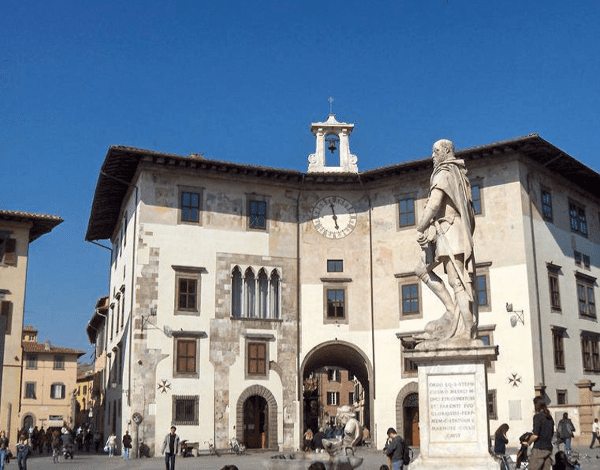
To the right of the Town Hall there were San Bastiano at the Major Factories, the church of the Seven Major Arts and the Orders of Wool, the Sea and Merchants.
And continuing through Via San Bastiano, the main scene of the battle we talked about, we find the Palazzo del Podestà and the door of San Felice, in front of the church of the same name, owned by the Visconti.
Life near the Arno River
Behind the arch of this door was the crowd that animated the village, the road that – joined to the Carraia thanks to the Nuovo Ponte di Arno (Ponte di Mezzo) – crossed the city from Porta del Parlascio to Porta di San Giglio.
From the left come the flows of the ancient forisportam that grew in the shadow of Santa Caterina, San Francesco and San Michele.
Here the constant noise of the workshops and local shops was the music that accompanied visitors from dawn to dusk.
At that time the houses had invaded the streets with their own arcades and the merchants began to transform the decadent houses-torre into palaces.
Going down towards the river, the left side was the territory of the Visconti, who controlled S. Pierino and the way of the Belle Torri.
On the right side there was an endless labyrinth of towers of vassals crammed around the tower of their Lord, each with its own small chapel, almost without space, with shops on the ground floor and overlooking the squares crammed with street vendors.

On the other side of the river stood very high tower houses with 8 or 9 floors, like those that are now hidden by the Royal Victoria, the Lanfreducci or the Gaetani.
The beautiful palaces of the Agostini Venerosi della Seta did not yet exist, and the Lungarno was an interrupted succession of tower and low houses.
The city accessed directly the river at the height of the beaches, where ships unloaded their goods after customs checks.
In the highest part of the shoreline were shops, banks and artisan shops.
The tower of Gherardesca had recently been destroyed the victors decreed the imperitant ban on reconstruction on those ruins: even today the house of Ugolino is in the state in which it was then left.
On both sides of the Ponte Nuovo there were small houses, like the ones we still appreciate today on Ponte Vecchio in Florence.
The entrance to the Carraia (today Corso Italia) was protected by the Podestà and Bargello towers, joined together by an arch.
Under the Tower of the Podestà was the Chapel of San Bastiano and in a lodge under the Bargello Tower gathered the universitas catalanorum, the Catalan merchants who still had an excellent relationship with Pisa and had recently obtained that the Pisans assigned them a consul who was concerned about their interests.

In those years the river was a dangerous place.
With the counts incited to rebellion by the Upezzinghi, Gaetani and Caprona, with the incursions of the Guelph League under the orders of Nino Visconti da Lucca, with the Florentines in the Valdera and the Genoese besieging the mouth and Livorno, Pisa was desperate.
In fact, he had placed all his hopes in Guido da Montefeltro, “the most noble our Latin Guido montefeltrano” praised by Dante in the Divine Comedy even if he meets him in Hell (Canto XXVII) where he ended up for a wrong advice given to Bonifacio, “the prince of the new Pharisees”.
Guido with his crossbowmen were so esteemed by the Pisans as well as the Florentines and Lucca, but the conditions for peace required him to leave the city of Pisa.
And we could not blame him since, thanks to Guido, Pisa had recovered the Valdera and the Maremma to Grosseto and had stopped the invasions that the enemies sent from both the north and the south.
